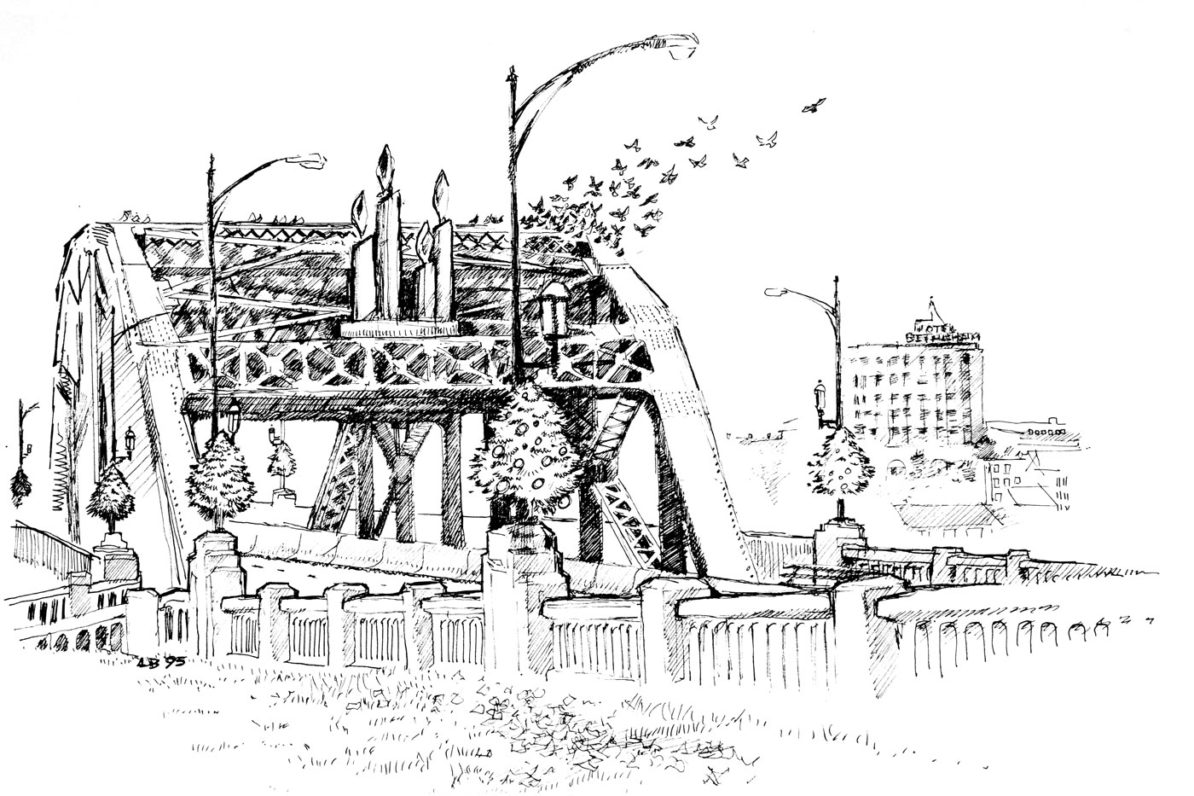
1995
Pen and Ink
10 inches x 10 inches
The 1924-built thirteen-span twelve arched Hill to Hill Bridge in Bethlehem.
The bridge represents a significant engineering achievement that required considerable creativity. Only the obscure engineering terms of the past can identify the bizarre structure of this bridge, the only known example of a “Hudson webbed through-truss span configuration” in the country. Concrete balustrades, arch span piers, closed spandrel deck spans, portal sway braces—all held together with 30-per-square-foot hot rivets. It was state-of-the-art Roaring Twenties architecture.
Acres of cement were poured for its arches; covered with decorative pillars and lighting to match: The 1600-foot Hill to Hill Bridge is one of the most unique bridges ever constructed.
Above the highway, modern painting crews found the girders and beams of the structure imprinted with the letters “BETHLEHEM”. The steel probably came up Third Avenue still hot from the mill.
Approach it from the South Side at the Sayre Mansion and the Old Society Hill area of Delaware Avenue where it crosses the Norfolk Southern RR and the tracks of the defunct Lehigh Valley Railroad. I remember my Mom driving the family Studebaker to Union Station under the bridge and dropping Dad off for the train to Philadelphia. The LVRR line is now a bike path running through the center of “South Side” around South Mountain and into the Saucon Valley.
The bridge crosses the Lehigh River, old Fritch Fuel properties, Sand Island, the 1820 Ice House, the lock, towpath and 1829 Lehigh Coal and Navigation Company Canal, the Central Railroad of New Jersey abandoned tracks where its 1878 High Victorian Second Empire Train Station and freight depot stand restored today, and finally the Monocacy Creek—with its 1935 WPA crafted walls and walkways .
The bridge once had five forks; on-ramps from streets below. It wasn’t until I was in high school that Penndot added the “spur route” onto the end of the original bridge shooting straight out towards the ABE airport. Until that time the Hill-to-Hill ended in mid-air and all traffic turned left for the west side (closed in 1967) or right towards Main Street where it ended at the steps of the Moravian Church. Here on Main Street virtually every building is on the National Register of Historic Places.
The Hill to Hill Bridge is also on that list.
The day is cold, the month is November. City crews have put up Christmas decorations and installed large advent candles on top of the structure, something it doesn’t do anymore. Here on the Bethlehem Hotel side of the bridge, I’m looking up at the span crossing the old canal with the sketchbook propped on the steering wheel trying to decipher Hudson’s precise engineering plan with my artists’ brain.
To me, the Hill to Hill is a series of arched caves topped by two gigantic half-moon webs of iron. I’ve been drawn to its structure on at least five separate occasions to render it properly. Doing so is to become entangled in an architectural mystery.

